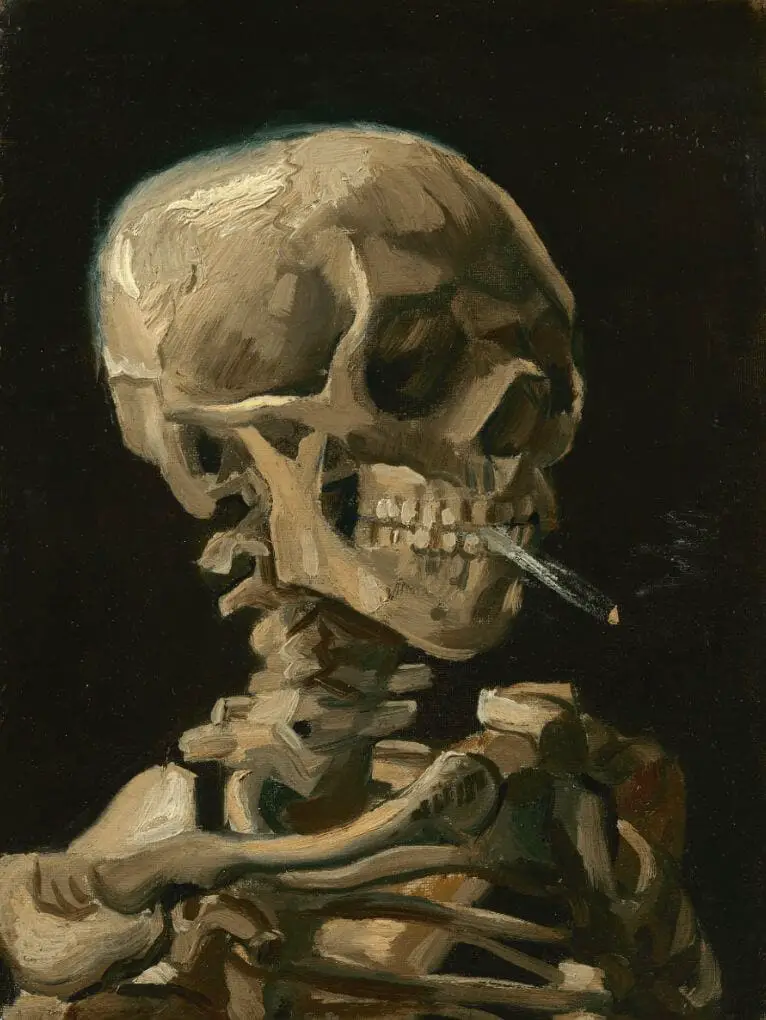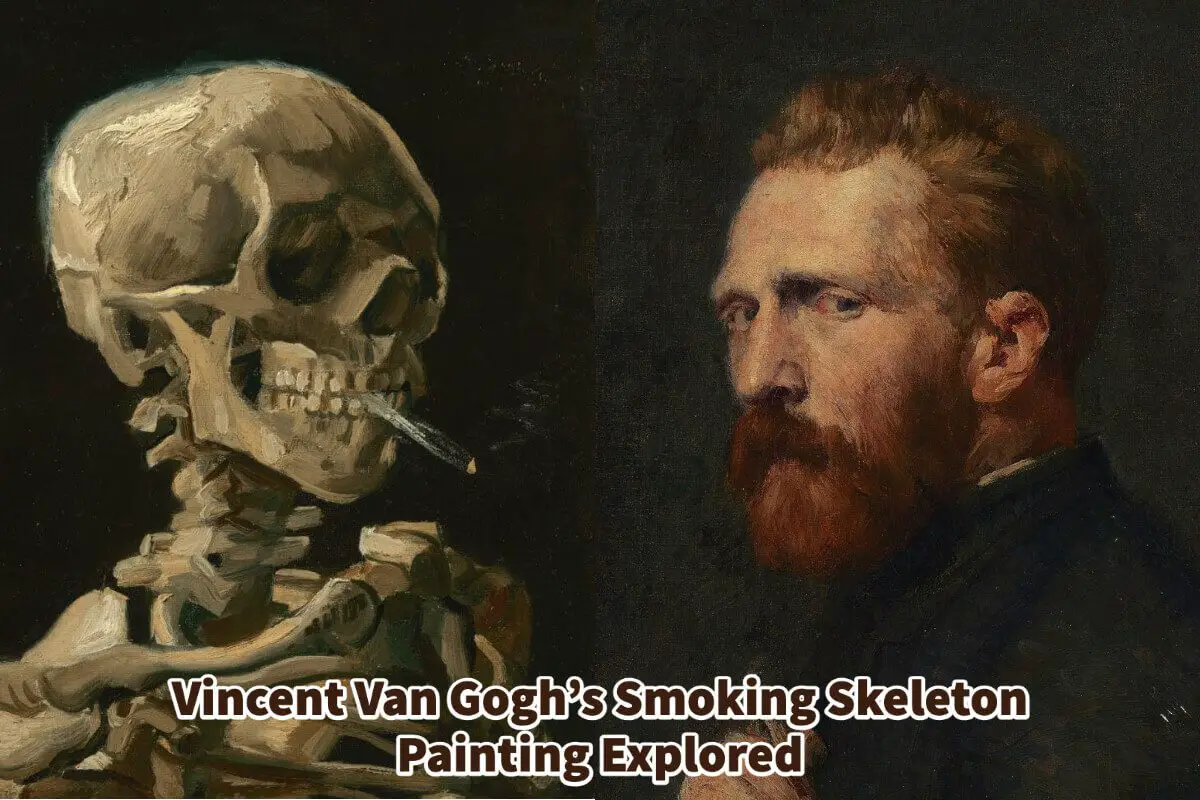One painting accommodated in the Van Gogh Museum in the Netherlands stands starkly apart from the typical repertoire of Vincent van Gogh. It’s an unusual depiction of a human skeleton smoking a cigarette, a striking divergence in color and style from Van Gogh’s more familiar works.
This artwork, known as ‘Head of a Skeleton with a Burning Cigarette,’ was crafted in 1886, using oil on canvas as the medium. Interestingly, this painting was initially conceived as a playful jest than a severe piece intended for museum display. Yet, this incredible artwork underscores the astounding talent and versatility of Van Gogh, showcasing an aspect of his creative genius that is often overlooked.
Table of Contents
- The Witty Side Of Van Gogh: Unveiling The “Head Of A Skeleton With A Burning Cigarette.”
- Understanding Van Gogh Through The Skeleton Painting
- The Journey Of The Painting
- Frequently Asked Questions
- Related Questions
Despite its unusual theme and appearance, ‘Head of a Skeleton with a Burning Cigarette’ is a powerful testament to Van Gogh’s artistic prowess, demonstrating his ability to excel beyond his characteristic style and infuse humor into his work. This is a testament to the multifaceted talent that Vincent Van Gogh indeed was.
The Witty Side Of Van Gogh: Unveiling The “Head Of A Skeleton With A Burning Cigarette.”
Artists often transcend beyond the conventional norms of their time, creating pieces that seem unusual yet profoundly insightful. They use their brushes and pigments to paint and convey messages, emotions, and unique perspectives.
One such artist is Vincent van Gogh. Despite the widespread acclaim for his Starry Night, Sunflowers, and other vibrant masterpieces, one of his early pieces—yet an atypical painting—found its niche in art and history.

This is the ‘Head of a Skeleton with a Burning Cigarette,’ an oil-on-canvas painting produced around 1886. Its unconventional presentation of a smoking skeleton diverges from Van Gogh’s usual style, inviting curiosity about the artist’s motivations and the painting’s implications.
The painting presently sits within the walls of the Van Gogh Museum in Amsterdam, continuing to baffle and intrigue visitors with its unique premise.
The Origin Story Of The Smoking Skeleton
Van Gogh painted this odd yet striking piece while studying at the Royal Academy of Fine Arts in Antwerp, Belgium, around early 1886. However, contrary to what one might assume, this piece was not a result of a solemn mood or a morbid fascination.
Instead, it stemmed from Van Gogh’s sense of humor, a facet of his personality that’s less known yet is delightfully highlighted in this painting.
During his time at the academy, the curriculum prescribed sketching skeletons as an exercise for developing a sound understanding of human anatomy. However, painting the skeletons was not part of this academic routine.
Thus, the creation of this painting must have taken place in Van Gogh’s time, between or after his formal lessons, lending it a touch of rebellion and freedom.
The Significance Of The Smoking Skeleton
Despite its positive motivation, the ‘Head of a Skeleton with a Burning Cigarette’ holds deeper meanings, making it a valuable part of Van Gogh’s portfolio.
Measuring 32 by 24.5 centimeters, this miniature oil painting is considered a ‘vanitas’ or ‘memento mori.’ These artistic genres emphasize death’s inevitability and the fleeting nature of human pleasures and achievements.
This painting, created when Van Gogh was not in the best health, resonates with this thematic convention. However, it also introduces an element of humor, reframing the traditional perspective towards mortality.
Even though Van Gogh’s smoking skeleton could be seen as a criticism of smoking, it’s important to note that Van Gogh himself was an avid smoker who continued to smoke until his death.
Also, during this time, smoking was not looked upon as it is today, and the fact that smoking can cause cancer or death was not on anyone’s radar.
Understanding Van Gogh Through The Skeleton Painting
The ‘Head of a Skeleton with a Burning Cigarette’ reflects several aspects of Van Gogh’s persona.
Firstly, it showcases his sense of humor. By choosing to paint a skeleton smoking a cigarette, Van Gogh infused a standard academic exercise with wit and satire, turning it into a visual joke. This depiction tells us that the artist was not merely a severe and troubled soul, as often portrayed, but had a playful and humorous side.
Secondly, this painting demonstrates Van Gogh’s solid grasp of human anatomy, a testament to his academic knowledge and keen observation. Such understanding helped him later paint humans with incredible realism and emotional depth, as seen in many of his famous pieces.
Finally, this painting underscores Van Gogh’s versatility as an artist. Although known for his Post-Impressionist works featuring vibrant colors and bold strokes, Van Gogh could also paint with darker tones and themes.
His skill set was comprehensive, flexible, and not limited to a single style or genre.
Listen To Our Podcast About Exploring Vincent Van Gogh’s Smoking Skeleton Painting below or by clicking here.

The Journey Of The Painting
The ‘Head of a Skeleton with a Burning Cigarette’ had quite a journey before it found its permanent place in the Van Gogh Museum in Amsterdam. Following Van Gogh’s death in 1890, the painting was held by his brother, Theo Van Gogh, who also passed away the following year.
After that, it was inherited by Theo’s widow, Johanna van Gogh-Bonger, who held it until she died in 1925. Subsequently, their son, Vincent Willem van Gogh, became the painting’s custodian.
The Van Gogh Foundation acquired the painting in 1962 and loaned it to the Stedelijk Museum from 1962 to 1973. Finally, it was permanently loaned to the Van Gogh Museum in Amsterdam in 1973.
Despite its travels and various homes, the painting remains well-preserved and continues to be an intriguing part of Van Gogh’s legacy.
A Spectrum Beyond Vibrant Colors: The Other Skull Paintings By Van Gogh
Interestingly, the ‘Head of a Skeleton with a Burning Cigarette’ is not the only work where Van Gogh dabbled with skeletal motifs. During his Antwerp period, he included skeletons in another sketch called the ‘Hanging Skeleton and Cat.’’

Later, in 1887-88, he painted two more pieces featuring skulls, demonstrating his willingness to explore unconventional themes.
The Legacy Of The Painting
Today, the ‘Head of a Skeleton with a Burning Cigarette’ is a fascinating reflection of Van Gogh’s versatility as an artist and his sense of humor. In a world that often associates Van Gogh with emotional intensity and tragic mental struggles, this piece provides a different perspective of the artist.
It paints a portrait of a man who found room for humor and creative expression amidst his struggles and the rigidity of academic studies.
While this piece may not resemble Van Gogh’s typical style, it remains an essential part of his artistic journey. The painting showcases his ability to maneuver between styles, play with themes, and inject his work with personal sentiments and perspectives, all of which are hallmarks of a great artist.
The ‘Head of a Skeleton with a Burning Cigarette’ is a testament to Van Gogh’s artistic prowess and humanly relatable sense of humor. Its existence challenges the standard perception of Van Gogh as an artist confined to a single style and mood.
While it may seem an anomaly in the vast canvas of his works, it fascinates art enthusiasts and historians with its backstory, potential symbolism, and the glimpses it offers into Van Gogh’s personality.
Above all, it stands as a reminder that humor and lightness coexist with profound insight and technique, making it a truly intriguing piece of art.
Anita Louise Art is dedicated to art education, great artists, and inspiring others to find and create their art. We love art that uplifts and inspires. #ArtToMakeYouSmile! #ArtToMakeYouHappy!
If you want to see any of my art, you can find out more by clicking here. If you are interested in what inspires me and my paintings, you can discover more by clicking here.
We have a free newsletter and would love you to be part of our community; you can subscribe to the newsletter by clicking here. If you have any questions, I would be happy to talk to you anytime. You can reach me, Anita, by clicking here.
Subscribe to our Anita Louise Art YouTube Channel with great videos and information by clicking here.
Join us for our podcast “5 Minutes With Art.” Spend just 5 minutes a week with us to discover and learn about great art and artists. You can find out more about our podcast by clicking here.
Frequently Asked Questions
What is the title of Vincent van Gogh’s smoking skeleton painting, and where is it currently housed?
Vincent van Gogh’s smoking skeleton painting is titled ‘Head of a Skeleton with a Burning Cigarette,’ and it is currently housed in the Van Gogh Museum in the Netherlands.
When was the smoking skeleton painting created, and what medium did Van Gogh use for this artwork?
The painting was created in 1886, and Vincent van Gogh used oil on canvas as the medium for this unusual masterpiece.
Why did Van Gogh create a painting of a smoking skeleton, and what was the initial intention behind it?
The painting of the smoking skeleton was initially conceived as a playful jest rather than a serious piece intended for museum display. Van Gogh’s original intention was more light-hearted than the gravity often associated with his other works.
How does the smoking skeleton painting differ from Van Gogh’s more familiar works in terms of color and style?
The smoking skeleton painting stands apart from Van Gogh’s more familiar works due to its striking divergence in color and style. It exhibits a unique and unusual approach compared to his typical repertoire.
What is the significance of ‘Head of a Skeleton with a Burning Cigarette’ in Van Gogh’s body of work?
This painting highlights the astounding talent and versatility of Van Gogh, showcasing a less explored aspect of his creative genius that deviates from the common themes associated with his art.
Was the smoking skeleton painting originally intended for museum display, or did it gain recognition later?
Contrary to its current place in the museum, the smoking skeleton painting was initially created as a playful piece and was not originally intended for serious museum display.
What inspired Van Gogh to depict a skeleton smoking a cigarette in this particular painting?
The inspiration behind Van Gogh’s choice to depict a skeleton smoking a cigarette remains a subject of speculation. It adds an intriguing layer to the artwork and invites viewers to interpret the symbolism behind this unusual composition.
How does ‘Head of a Skeleton with a Burning Cigarette’ reflect Van Gogh’s artistic evolution during the year 1886?
The smoking skeleton painting provides insights into Van Gogh’s artistic evolution in 1886, showcasing his willingness to experiment with unconventional subjects and styles during this period.
Are there any hidden symbols or meanings in the smoking skeleton painting that art historians have uncovered?
Art historians have explored potential hidden symbols or meanings in the smoking skeleton painting, adding depth to its interpretation. However, these interpretations may vary, and the painting’s true significance remains open to individual perspectives.
What impact has ‘Head of a Skeleton with a Burning Cigarette’ had on the perception of Van Gogh’s legacy in the art world?
The smoking skeleton painting has contributed to a broader understanding of Van Gogh’s legacy, emphasizing his versatility and ability to explore unconventional themes. It adds a unique dimension to his artistic reputation beyond the more well-known aspects of his oeuvre.
Related Questions
What Was The Impact Of Vincent Van Gogh On The Art World?
Van Gogh used color, form, and emotions in his art. He had a bright palette that was individualized for his time. Even though he did not see a lot of success during his life after he died, the impact of his art can be seen in both the Expressionism and Fauvism movements that were taking place in Europe.
By clicking here, you can learn more by reading What Was The Impact Of Vincent Van Gogh On The Art World?
Similarities Between Claude Debussy And Claude Monet
Claude Debussy is a musical composer. Claude Monet is an artist. They are both considered Impressionists and were not afraid to break from the tradition of their day to create something new. Both Debussy and Monet greatly influenced many artists that went after them.
By clicking here, you can learn more by reading Similarities Of Claude Debussy And Claude Monet.
What Is A Japanese Woodblock Print?
A Japanese woodblock print is, as the name implies, a print that is made by using carved woodblock and applying ink on the woodblocks to print a design on paper. Japanese woodblock artists use woodblocks to print artistic prints and even books. Artists have used the woodblock print technique in Japan for hundreds of years.
You can learn more by reading What Is A Japanese Woodblock Print? by clicking here.

